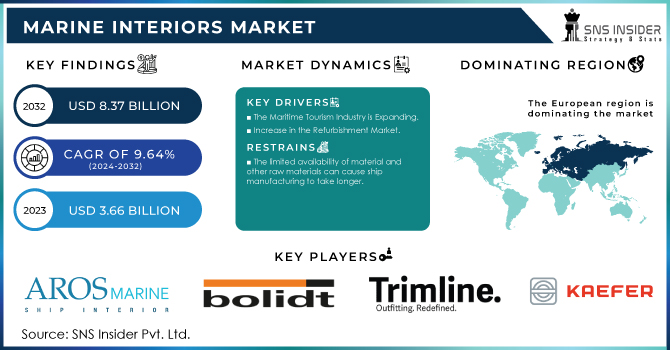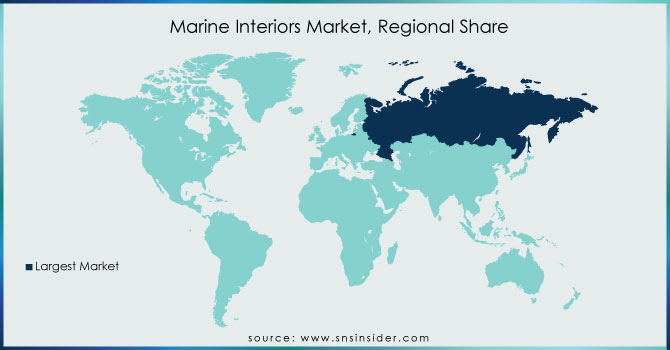Marine Interiors Market Report Scope & Overview:

To get more information on Marine Interiors Market - Request Free Sample Report
The Marine Interiors Market size was valued at USD 3.66 billion in 2023 and is expected to reach USD 8.37 billion by 2032 with a growing CAGR of 9.64% over the forecast period 2024-2032.
The domestic maritime market is concerned with the design, refurbishment, and delivery of internal commercial and defense shipping solutions. In recent years, due to rising urbanization and standard of living, the demand for luxury cruise ships, yachts, and canoes has grown exponentially. This has led to an increase in the demand for advanced marine interior materials, which are lightweight and easy to install. Aluminum, composites, metals, etc. are widely used in the interior of ships, due to their ability to withstand harsh environmental conditions such as humidity and humidity. However, composite materials are preferred as the material is lightweight and can be supplied under complex conditions. The maritime tourism industry is a major consumer of marine interior and is one of the major industries that drive market growth. In addition, the development of the aftermarket interior design of the ship also supports market growth.
The global marine interior market has expanded quickly in recent years, owing mostly to increased seaborne trade and the thriving maritime tourism industry. Additionally, the rise of the refurbishment sector is driving the growth of the marine interior market. However, significant downtime in ship refit is expected to hinder the market growth.
MARKET DYNAMICS
KEY DRIVERS
-
The Maritime Tourism Industry is Expanding
-
Increase in the Refurbishment Market
RESTRAINTS
-
Long material lead times will limit market growth.
-
The limited availability of material and other raw materials can cause ship manufacturing to take longer.
OPPORTUNITIES
-
Growth in Seaborne Trade
-
Increased demand for passenger ships from Asian shipyards, new interior designs, and an increase in consumer disposable income
THE IMPACT OF COVID-19
The cruise ship and yacht markets have been badly impacted as a result of manufacturing plant closures in major countries throughout the world. Unavailability of labour has also had an impact on the marine interiors market as a result of COVID-19, as people are forced to keep social distance and avoid travel due to limitations. Furthermore, revenue generation has been reduced because all ships have been stuck and barred from accessing ports, preventing them from loading or unloading their cargo. Furthermore, there was a disturbance in the supply chain of raw materials used to construct maritime interiors, causing delivery to be delayed. Furthermore, the cancellation of a number of orders for refurbishment as a result of the global economic slump has impacted the marine industry, which has decreased the market growth.
The commercial segment of the marine interiors market is expected to develop at the fastest CAGR. The demand for interiors is heavily influenced by the new order books and dry dock schedules for cruise ships and yachts. The demand for cruise ship interiors is entirely based on the order book. The need for marine interiors is not just confined to new build ship order books, but also to dry dock renovation, in which cruise ships get partial or total interior upgrades every two to three years.
The marine interiors market is divided into aluminium, steel, composites, joinery, and others. From 2022 to 2028, the composites segment of the marine interiors market is expected to develop at the fastest CAGR. Composites have enormous potential for weight savings and the development of complicated shapes. As a result, they are used in the production of superstructures. Composites appear to be a natural material for use in shipbuilding due to their non-corroding finish and sheer adaptability.
During the forecast period, the re fit sector of the marine interiors market is expected to develop at a faster CAGR than the news segment. Various cruise lines are developing renovation plans to improve the interiors of their ships while reducing capital cost.
REGIONAL ANALYSIS
The European market has registered the highest share with a market capitalization of USD 1.15 billion by 2022. The large share was created by the presence of a few major shipbuilders and suppliers of inland parts such as STX Europe A Meyer Werft, Fincantieri SpA, Trimline Lut, Kaefer Gambit, Marine Interiors Spa, and Mivan Marine Le Asia Pacific it is expected to grow at its highest combined annual growth rate from 2022 to 2028. The growth is due to the rapid growth of the maritime industry in developing countries such as China and India in addition, several procurement efforts, demand for modem equipment, and the growing number of shipping facilities in China Support market growth in Asia Pacific. The North American market has registered the second highest share. due to the prosperity of the maritime industry in the region, the presence of large maritime vessels, and significant investment in the maritime sector. These factors create the need for maritime solutions in North America Globally, the market will witness significant growth between 2021-2028 Mark development is appropriate.

Need any customization research on Marine Interiors Market - Enquiry Now
KEY PLAYERS
The Major Players are Aros Marine, Bolidt Systems, Marine Interiors Spa, NORAC AS, R&M Group, Trimline Ltd, Forbo Flooring Systems, Kaefer GmbH, Mivan Marine Ltd, ALMACO Group, and other players
| Report Attributes | Details |
|---|---|
| Market Size in 2023 | US$ 3.66 Billion |
| Market Size by 2032 | US$ 8.37 Billion |
| CAGR | CAGR of 9.64% From 2024 to 2032 |
| Base Year | 2023 |
| Forecast Period | 2024-2032 |
| Historical Data | 2020-2022 |
| Report Scope & Coverage | Market Size, Segments Analysis, Competitive Landscape, Regional Analysis, DROC & SWOT Analysis, Forecast Outlook |
| Key Segments | • By Product (Ceilings & Wall Panels, Furniture, Galleys & Pantries, Lighting) • By End User(New Fit, Refit) • By ship Type (Commercial, Defense) • By Material (Aluminum, Steel, Joinery, Composites) • By Application (Passenger Area, Public Area, Crew Area and Utility Area) |
| Regional Analysis/Coverage | North America (USA, Canada, Mexico), Europe (Germany, UK, France, Italy, Spain, Netherlands, Rest of Europe), Asia-Pacific (Japan, South Korea, China, India, Australia, Rest of Asia-Pacific), The Middle East & Africa (Israel, UAE, South Africa, Rest of Middle East & Africa), Latin America (Brazil, Argentina, Rest of Latin America) |
| Company Profiles | Aros Marine, Bolidt Systems, Marine Interiors Spa,NORAC AS, R&M Group, Trimline Ltd, Forbo Flooring Systems, Kaefer GmbH, Mivan Marine Ltd, ALMACO Group, and other players. |
| DRIVERS | • The Maritime Tourism Industry is Expanding • Increase in the Refurbishment Market |
| RESTRAINTS | • Long material lead times will limit market growth. • The limited availability of material and other raw materials can cause ship manufacturing to take longer. |

